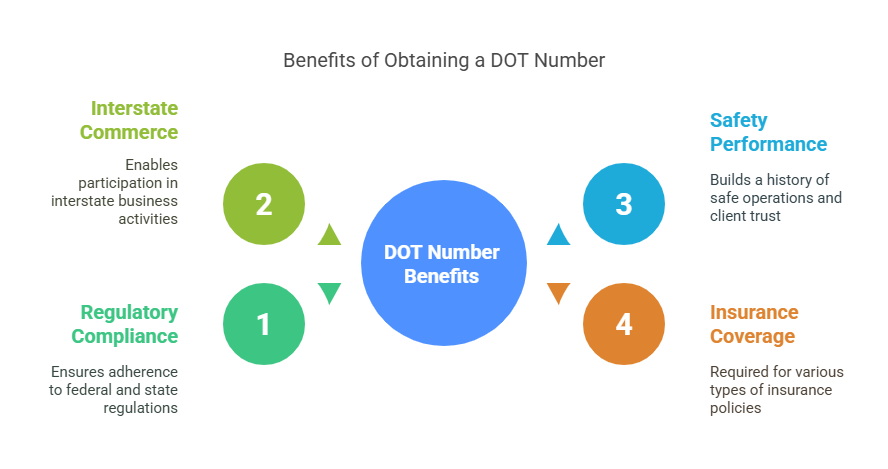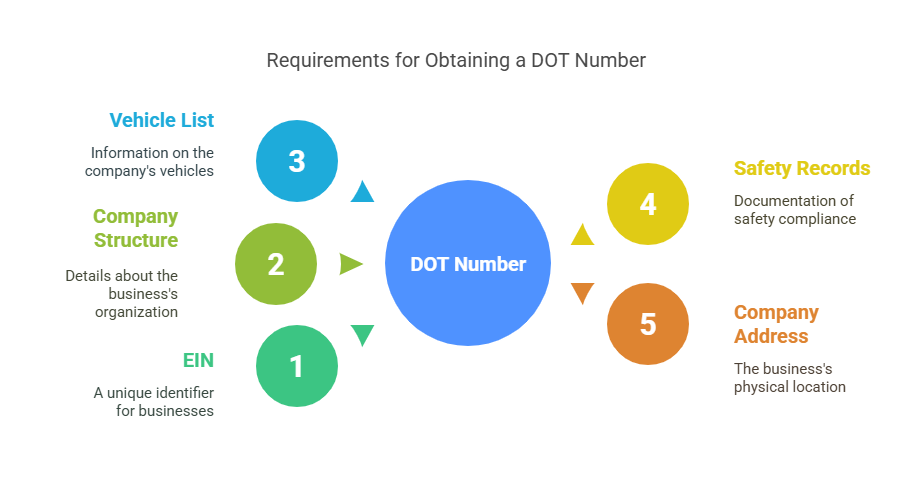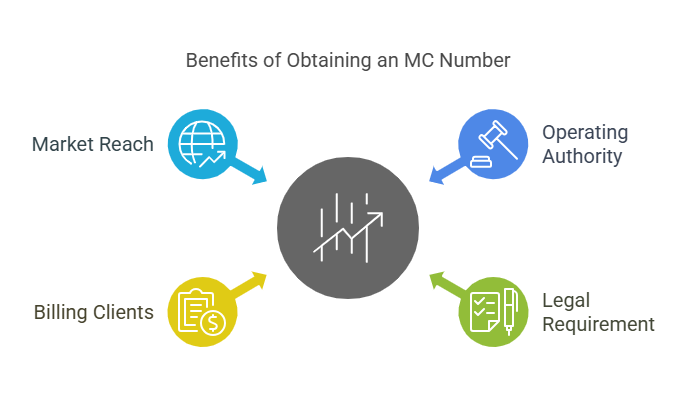If you’re looking to start a trucking business or operate as a for-hire carrier across state lines, understanding the Federal Motor Carrier Safety Administration (FMCSA) requirements is essential. One of the first steps in establishing a legitimate motor carrier business is navigating the process of getting your DOT number and MC authority. This guide walks you through everything from understanding what you need to get a DOT number to applying for your motor carrier number and the difference between the two.
What Is a DOT Number and Why Do You Need One?
A DOT number is a unique identifier assigned by the FMCSA to track a company’s safety information during inspections, compliance reviews, crash investigations, and audits. If your vehicle meets any of the following criteria, you are required to obtain a DOT number:
- Operates a vehicle with a gross vehicle weight rating (GVWR) of over 10,000 pounds
- Transports more than 8 passengers (including the driver) for compensation
- Transports more than 15 passengers without compensation
- Hauls hazardous materials in quantities requiring placarding
Benefits of getting a DOT number:
- Ensures compliance with federal and state regulations
- Allows participation in interstate commerce
- Builds a safety performance history and trust with clients
- Required for many types of insurance coverage

According to FMCSA data, over 700,000 carriers are registered with active USDOT numbers in 2024, and commercial vehicle enforcement officers conduct more than 3.5 million inspections annually (FMCSA, 2024)
“Understanding the importance of a DOT number early on can help new carriers avoid legal issues and build strong industry partnerships.”
Are there specific types of freight or routes you plan to haul that make the DOT number especially important for your business?
What Is a USDOT Number?
A USDOT number is simply the full name for a DOT number issued by the U.S. Department of Transportation. It functions the same but is used interchangeably in many contexts. If you’re asking how to get a USDOT number or how to get a DOT, the process is the same.
How to Apply for a USDOT Number
Applying for a USDOT number is done online through the FMCSA’s Unified Registration System (URS). Here’s a detailed step-by-step process:
- Determine your eligibility: Confirm whether your operation type requires a USDOT number.
-
Gather the necessary information:
- Legal business name and DBA (if any)
- Employer Identification Number (EIN) or Social Security Number
- Company operation type (e.g., for-hire, private)
- Cargo classification and vehicle details
- Number of vehicles and drivers
- Contact information
- Visit the FMCSA URS portal: This is the official place for your USDOT number application.
- Complete the online form: Provide all required business and vehicle information.
- Submit and receive your DOT number: Once reviewed, your number is issued immediately.
What do you need to get a DOT number?
- Employer Identification Number (EIN)
- Company structure details
- List of vehicles (make, model, year)
- Safety and compliance records
- Company address and contacts

“Properly gathering your business details before applying can significantly speed up your USDOT registration process.”
Looking to streamline the DOT number application process? Get expert support here.
What Is a Motor Carrier Number and Why Do You Need One?
A motor carrier number, also known as an MC number, is issued by the FMCSA and is required for companies that transport regulated commodities for hire across state lines. While a DOT number tracks safety and compliance, the MC number authorizes business operations.
Benefits of getting an MC number:
- Grants operating authority for interstate commerce
- Legal requirement for transporting for-hire freight
- Allows billing clients for hauling services
- Increases market reach and revenue potential

If you’re asking do I need an MC number, the answer is yes if you’re a for-hire carrier transporting regulated goods across state lines. As of early 2025, more than 185,000 carriers in the U.S. possess active MC authority (FMCSA, 2025).
“Securing your MC number not only makes you compliant, it opens the door to more lucrative contracts and wider market access.”
Have you considered the types of contracts or clients you might miss without having active MC authority?
What is MC DOT Registration?
MC DOT registration refers to the process of registering for both a Motor Carrier (MC) number and a DOT number with the FMCSA. This combined registration is crucial for trucking businesses that intend to operate across state lines and haul regulated commodities.
When completing your MC DOT registration, you are:
- Applying for your USDOT number application through the FMCSA’s Unified Registration System (URS)
- Submitting documents to obtain your MC certificate of authority
- Ensuring you meet all MC number requirements and motor carrier number requirements
The purpose of MC DOT registration is to ensure that both your safety compliance and for-hire operating authority are approved. Whether you’re searching how to get a DOT number or how to obtain a MC number, this dual process is vital for launching a fully compliant trucking operation.
According to TruckingInfo (2024), many new entrants to the industry are delayed not because of licensing problems, but due to misunderstanding registration workflows like MC DOT registration.
“Think of MC DOT registration as the backbone of your trucking authority, it integrates all required elements for full legal operation.”
What part of the MC DOT registration process feels most confusing or time-consuming to you?
How to Obtain an MC Number
If you’re wondering how to obtain an MC number or how to apply for a motor carrier number, follow these steps:
- Register with the FMCSA: You can start at the same URS portal used for DOT numbers.
- Select your operating authority: Choose the correct classification (e.g., carrier of household goods, broker, freight forwarder).
- Submit your application: This includes business details, insurance information, and your planned operations.
- File a BOC-3 form: Designate a process agent in each state you operate.
- Submit proof of insurance: The FMCSA requires insurance filings for your authority to be active.
- Pay the application fee: A one-time fee is required.
You’ll be issued your MC certificate of authority after these steps are completed.
“Your MC number is your ticket to haul freight legally, getting it right the first time is crucial to avoid costly delays.“
Looking for help securing your MC authority? Get back-office support here.
The Difference Between a DOT Number and an MC Number
Here is the common difference between DOT Number and an MC number:
| Feature | DOT Number | MC Number |
| Purpose | Safety tracking & Compliance | Authorization for for-hire transport |
| Who needs it | Most Carriers | For-hire carriers operating interstate |
| Issued by | FMCSA | FMCSA |
| Includes | Safety record, Compliance history | Operating Authority |
Though often mentioned together, a DOT number and an MC number serve different purposes:So if you’re asking what is a motor carrier number vs. how to get a DOT, remember that the DOT number is about safety, while the MC number is about legal operating authority.
“Understanding the distinction helps prevent registration errors that can delay your ability to operate.”
Do you currently need both a DOT and an MC number or just one to get your trucking business on the road?
Frequently Asked Questions (FAQs)
1. How do I get a DOT number for my trucking company?
To get a DOT number, visit the FMCSA Unified Registration System (URS), complete the DOT number application, and submit required business and vehicle information. This answers the common question of how to get a DOT number or how to apply for a USDOT number as part of your initial compliance steps.
2. Do I need an MC number if I already have a DOT number?
Yes, if you plan to operate as a for-hire carrier across state lines or transport regulated commodities, you need both. Many carriers ask do I need an MC number, and the answer is yes if you’re involved in interstate for-hire operations.
3. What is the difference between a DOT number and a motor carrier number?
A DOT number monitors safety and compliance, while the MC number provides your operating authority to transport goods for hire. Understanding MC number requirements versus DOT requirements is crucial when setting up your business.
4. What are the MC DOT registration steps I should follow?
MC DOT registration involves applying for both your DOT number and MC authority through the FMCSA portal. You’ll need to submit business information, insurance details, and file necessary forms like the BOC-3. If you’re asking how to obtain a USDOT number or how to apply for a motor carrier number, this combined registration is where to start.
Start Strong with Proper Trucking Registration
Launching a successful trucking business begins with getting your paperwork right. From securing your DOT number to completing your MC number registration, each step ensures your business stays compliant and ready to operate. Your USDOT application builds your safety profile, while your MC authority gives you the green light to cross state lines with confidence.
Ready to launch your trucking business the right way? Contact us and let our experts guide you through DOT and MC registration with ease.
Reference
- FMCSA. (2024). Motor Carrier Management Information System Snapshot. Retrieved from https://ai.fmcsa.dot.gov
- FMCSA. (2025). Registration Statistics. Retrieved from https://www.fmcsa.dot.gov/registration
- TruckingInfo. (2024). New Entrant Safety Audits and FMCSA Processes. Retrieved from https://www.truckinginfo.com




